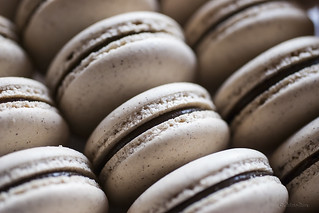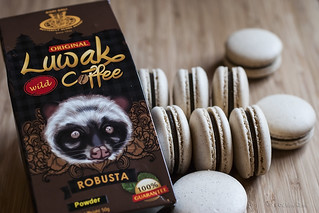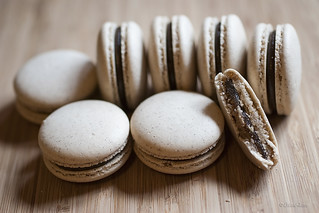Asian-inspired flavors: Kopi Luwak macarons
Finally, here’s number 5 of my Asian-inspired macaron flavors series: Kopi Luwak macarons with Kopi Luwak ganache. This one is inspired by this year’s trip to Bali, Indonesia. Besides the Ulun Danu temple (a.k.a. Bedugul temple) on Lake Bratan in Bedugul, the island is known for the very exclusive Kopi Luwak.
 Pura Ulun Danu, Danao Bratan, Bedugul, Bali, Indonesia.
Pura Ulun Danu, Danao Bratan, Bedugul, Bali, Indonesia.
Kopi Luwak is a type of coffee produced from beans that have been digested by the palm civet. This unique production procedure is what makes it the most expensive coffee in the world, fetching as much as $100 per cup.* Taste-wise, Kopi Luwak is also quite unlike any cup of coffee—it is «smoother» in a sense, and has considerably less of the bitter after-taste usually associated with regular coffee.
* Needless to say, this might be my first and last attempt translating this coffee drink into macaron form. Apart from the cost, the taste might not exactly be favored by your typical coffee aficionados 😅
____________________
Kopi Luwak macarons
Kopi Luwak macaron shells
Makes about 56-60 shells (28-30 filled macarons)
100 g finely ground almonds (almond meal/flour)
100 g confectioner’s sugar
5 g Kopi Luwak powder
37 g egg whites (from approximately 1 egg)
100 g granulated sugar
37 g egg whites (from approximately 1 egg)
25 g water
- Line baking trays with baking paper, silicone macaron mats or silpat (I used silpats).
- Tant pour tant: Grind the ground almonds, confectioner’s sugar, and Kopi Luwak powder in the food processor. Sift the mix into a large bowl. Place the pieces that won’t go through the sieve back in the food processor and process until everything goes through the sieve. Make a well in the center of the tant pour tant.
- Pour the egg white mixture in the middle of the tant pour tant but do not mix. Set aside.
- Italian meringue: Place the water and sugar in an appropriately sized saucepan. Place a digital kitchen thermometer (I used a digital meat thermometer with an alarm function) in the center of the pan with the sugar mixture, and heat over medium heat until the sugar syrup boils and reaches a temperature of 118°C. DO NOT STIR, but you can swirl gently.
- Place the second batch of egg whites in the bowl of a standing mixer fitted with the whisk attachment. When the sugar syrup temperature reaches past 112°C, begin whipping the egg whites at high speed until soft peaks form.*
- As soon as the sugar syrup reaches 118°C, remove from heat and pour in a thin stream into the egg whites while continuing to beat at high speed. Beat one more minute, then lower the speed to medium and beat for about 2 more minutes. Cool to 50°C (or lower) before adding into the tant pour tant.
- Macaronage: Add the meringue to the tant pour tant. Using a spatula, fold the meringue into the tant pour tant then from the center, move the spatula towards the side, pressing the batter against the side of the bowl, while rotating the bowl. Next, scrape the batter from the sides and bring it towards the center. Repeat this fold, press and scrape action while rotating the bowl until the batter becomes shiny and homogenous in color.
- Once the batter is shiny and homogenous, check for the consistency. Using the spatula, lift a small amount of batter and let it drop from the spatula. If the batter drops in clumps, fold a couple more times then check again. The batter is ready for piping when it drops from the spatula in ribbons that smooth themselves back into the rest of the batter within 15-20 seconds. Alternatively, check how the batter flows: tip the bowl slightly to one side and watch how the batter moves. If the batter moves like slowly flowing lava, it is ready.
- Spoon or pour the batter into a piping bag fitted with an 11-12 mm diameter round nozzle (Wilton 1A or 2A), taking care not to add air bubbles into the batter as you are doing so.
- Pipe out 35 mm circles, each about 20 mm apart, onto the prepared baking sheets.** Rap the sheets on the counter top to smoothen the tops of the macarons (in case there are stubborn peaks that formed while piping) and to dislodge/remove excess air from the batter.
- Croûtage: Let the macarons rest for 15-30 minutes,¨ or until they have formed a thin crust, their surfaces are dull in color and are no longer sticky when touched.
- Preheat the oven to 150°C-160°C (this depends on your oven; mine is hotter than what it says on the dial, so I use 150°C).
- Once the oven is done preheating and the macarons are dry and ready, place one of the baking sheets on the lower third of the oven—you can only bake one sheet at time. Bake for 10-12 minutes (again, this depends on your oven; in my case, I check for doneness after 10 minutes), briefly opening the oven at least once after 8 minutes to let out steam/moisture. The macarons are ready when the tops are firm to the touch and the tops do not move too much from side to side.
- Remove from the oven and slide the baking paper/silicone/silpat with the macarons still on it from the baking sheet onto a wire rack. Let the macarons cool on the baking paper/silicone/silpat. Once cooled, they can be removed easily from the baking surface (peel the baking surface from the macarons, and not vice-versa); any macaron with the bottom still stubbornly sticking to the baking surface is undercooked—pop them back into the oven and bake a couple more minutes.
- Pair the finished macarons and allow to rest on wire racks with half of them lying foot side up. Cool completely before piping the filling.
Kopi Luwak ganache
100 g white chocolate
100 ml pouring cream (or whipping cream)
5-7 g Kopi Luwak powder
20 g butter, diced
- Chop or grate the chocolate into small pieces so they melt evenly.
- Place the cream in an appropriately sized saucepan over medium heat. When it starts to simmer, add the Kopi Luwak powder.
- When the coffee-cream mixture starts to boil, remove from heat and pour over the chocolate. Stir using a whisk until mixture becomes homogenous.
- Cool the ganache slightly. When the temperature has cooled down to 40°C, stir in the diced butter. Continue stirring until the ganache becomes smooth.
- Pour the ganache into a shallow dish (i.e. a gratin dish), cool, then cover with plastic wrap (the wrap should touch the surface). Refrigerate at least one hour to set.
- Spoon into a piping bag fitted with 8-10 mm diameter round nozzle (Wilton 12).
Assembly
- Pipe the ganache onto half of the macarons (those with the foot side facing upwards), leaving about 3 mm from the edges ganache-free.
- Top the ganache with the remaing macarons.
- Leave the macarons to «mature» with the fillings for 24 hours, or at least overnight.





Comments